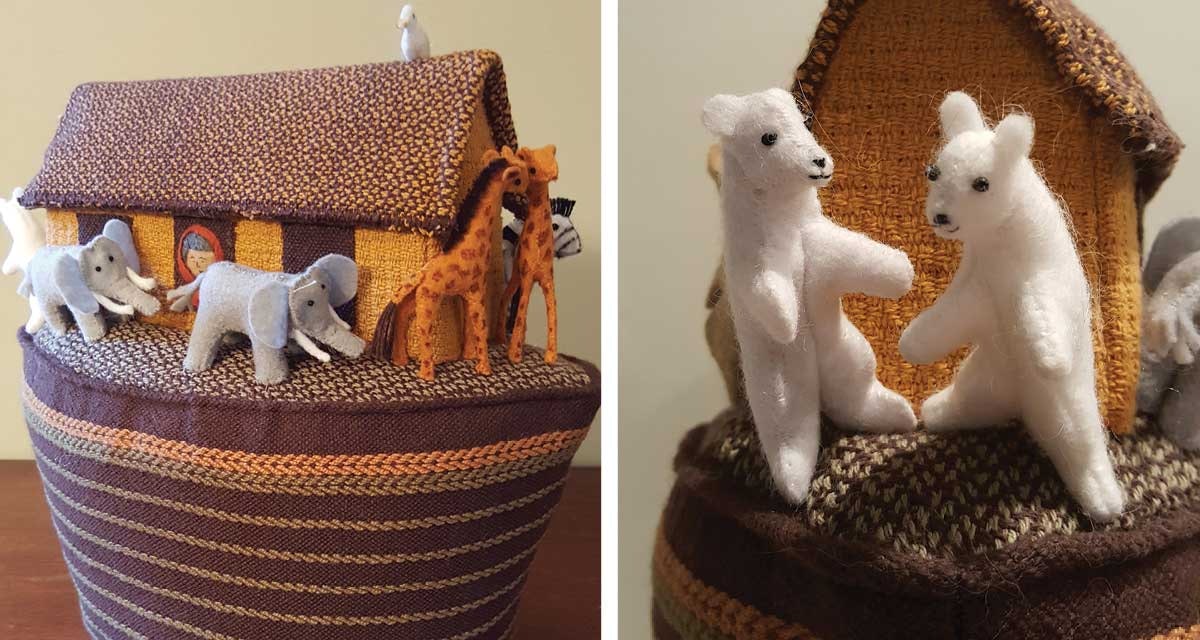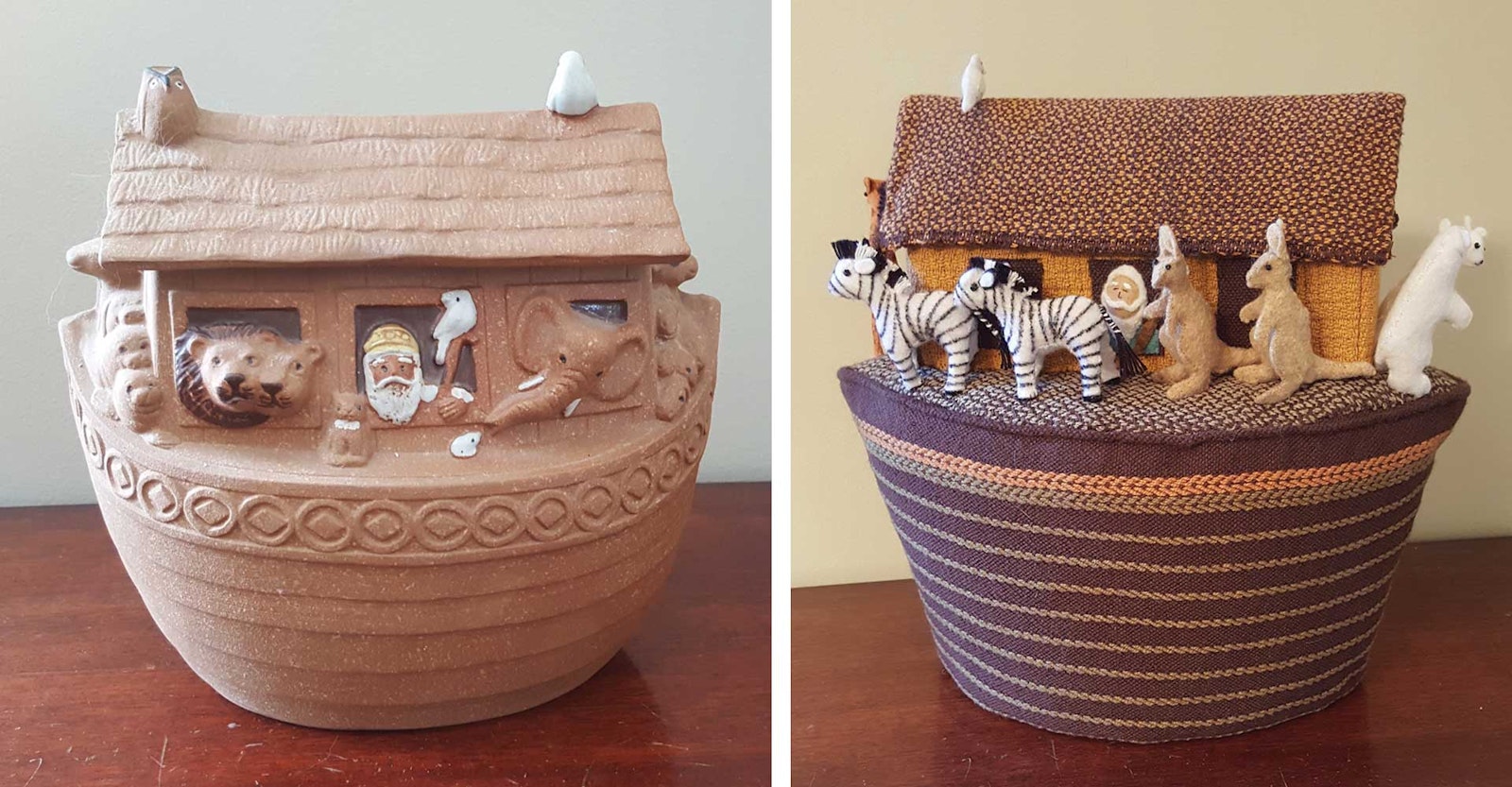For any artist, inspiration arrives as a welcome gift. Some find their muse in nature or perhaps hanging on the wall of an art museum. My inspiration came from something sitting on my kitchen counter: a ceramic Noah’s Ark cookie jar.
I’ve had this cookie jar for a long time, but it has never faded into the clutter of my kitchen counter. The brown clay ark is unadorned except for a few glazed accent colors. Noah, staring out at me from a cabin window with his white hair, has always caught my eye whenever I glance in his direction. The anonymous designer used minimal color and simple incised lines to create texture. The curving parallel lines on the ark suggest the planks of an old wooden ship hull, and a series of short lines on the top of the cabin imply a thatch roof. The artist told a timeless story in brown clay. I’ve always viewed this ark as an enchanting ceramic sculpture, but the only inspiration I ever felt when admiring it was the occasional motivation to bake cookies for my grandchildren.
The Initial Spark
I first started thinking about creating texture through weave structures during a workshop for advancing twill. The foundation concepts unfolded logically and I involuntarily nodded my head in understanding. Then I stopped nodding. Within seconds of “getting it,” I didn’t “get it.” The seminar continued without me, and judging from the continuing nods of understanding all around me, I knew I had been left behind.
Then I noticed something more interesting to me than the threading and treadling sequences being discussed: the twill drawdown looked like the patterned skin of a giraffe. That was my weaving epiphany. I could simulate actual textures and patterns through my weaving! How could I use my new magic power? The answer came when, by chance, I saw the plaited twill dinosaurs in The Best of Weaver’s: Twill Thrills and I knew I had found my weaving sweet spot: the land of soft sculpture.
The First Designs
A Weaver’s Book of 8-Shaft Patterns by Carol Strickler has enough plaited twill drafts in Chapter 10 to suggest the scaly skin of just about every creature, past and present. Using 10/2 pearl cotton at 30 ends per inch, I watched as dinosaur skin slowly took shape on my loom. For my first soft sculpture, I designed a jaunty stegosaurus with a row of felt bony plates along its back. I made five more before the fascination of seeing how stuffing made this creature come to life finally wore off.
Still reveling in my ability to simulate scales, I decided to move on from a prehistoric creature to an imaginary one. I turned to a different plaited twill draft, this time using 5/2 pearl cotton to create a contemplative, serene mermaid. After that, I knew I had reached the end of my “scale” period.
Making the Ark
Without any inspiration for a new soft sculpture, I resumed two-dimensional weaving as usual. It wasn’t until a fellow guild member passed around a scarf for show-and-tell that a new idea for a soft sculpture was born. The scarf was woven in dimity, which uses a close sett to create raised-twill warp stripes. There it was! I was looking at the perfect weave structure for the hull of a woven Noah’s Ark. Inspiration immediately replaced the few remaining chocolate chip cookie crumbs at the bottom of the jar.
After the inspiration came the perspiration. How in the world could I distill the charm of this ceramic container and translate it into a handwoven soft sculpture? Figuring out what I loved about the cookie jar was easy: a graceful hull shape and a realistic cabin filled with curious animals gazing out from its windows, and, of course, Noah, with his bushy white beard, holding a stick with a white dove perched on top. These were the elements I needed to reproduce in fabric instead of clay.
Working with old manila file folders, I began cutting out patterns for a hull. Many revisions later, I had the shape I wanted. Conveniently, the November/December 2008 issue of Handwoven included an article on dimity scarves by Sally Orgren, the same weaver who had inspired me with her dimity scarves at the guild meeting.
I once again turned to Carol Strickler’s book to find weave structures to simulate the texture and look of a deck, cabin, and roof. Her chapter on simple straight twill threading and treadling with tie-up variations gave me the other elements of the ark.

Left: Elephants, giraffes, and Noah’s wife, Naamah, can be found on the other side of the ark. Right: Two tiny handsewn polar bears guard the ark’s stern.
Making a Menagerie
There was nothing easy about making the animals. I found patterns on the internet, but they all had to be scaled down to mere inches to fit on the deck. At first, I naively thought I could weave the fabric for each animal, but when I thought about sewing ½-inch darts and minuscule seam allowances in handwoven fabric, I opted for sanity. Felt was the better choice, but even with that nonshredding, forgiving fabric, the tiny animals took painstaking work. Just as with garment construction, I had to copy the pattern marks for shaping darts directly onto the felt. When marking the darts for the elephants, I must have pressed very hard—those marks are now a permanent part of my kitchen table.
My handwoven Noah’s Ark is my all-time favorite project. I still enjoy “normal” weaving, but nothing has brought me the joy this piece of folk art brings whenever I look at it, and I know why: it’s because this Noah’s Ark soft sculpture is filled with my spirit instead of with cookies.
Resources
- Orgren, Salley. “Divine Dimity Goes Technicolor.” Handwoven November/December 2008, 52–54.
- Stickler, Carol, ed. A Weaver’s Book of 8-Shaft Patterns. Loveland, Colorado: Interweave, 1991.
- van der Hoogt, Madelyn. Best of Weavers: Twill Thrills. Souix Falls, South Dakota: XRX, 2014.

